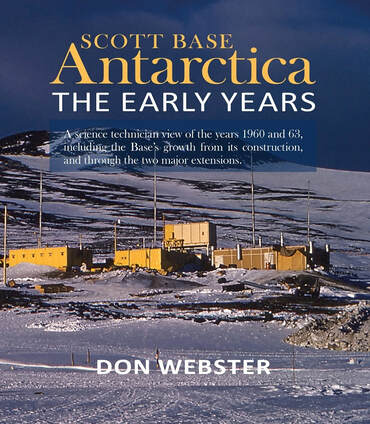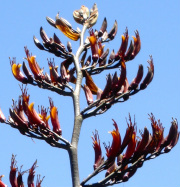
by Don Webster
Don Webster’s book began as a project to document photographs he had taken during two expeditions to Scott Base during the early sixties. His first expedition began at the end of 1959 when he was one of four young science technicians who, together with a senior technical officer, boarded HMNZS Endeavour for a fourteen-day voyage to the Antarctic. His second trip in 1963 was by plane.
Webster’s career began in 1957 as a technical trainee in a government laboratory, part of the Department of Science and Industrial Research (DSIR). His training and work as an electronics technician led to him being selected for the Antarctic over-winter team. Preparation for the job included learning about the Antarctic, making and recording observations in the field and the Auroral radar which New Zealand had been offered by Stamford University in the USA. Little of this prepared them for venturing into the Southern Ocean on board the 190 foot wooden Endeavour.
The author describes the journey south to the ice shelf, and Scott Base as it was when they arrived there. A shortage of accommodation saw them sleeping outside in tents until someone discovered the deep snow of their campsite was where explosives were kept.
There is a good deal of specific detail about the layout of Scott Base on Ross Island and how it was developed and added to over the years. The huts, labelled A, B, up to F – separated from one another and joined by an enclosed access way – included accommodation, messroom, laboratories, radio and machinery spaces.
We are taken on a tour of the work they did and how they socialised and entertained themselves. They had to adapt to sixteen weeks of continuous daylight in summer and sixteen weeks without sunlight during winter. During summer other parties came in by sea or air to carry out research projects or to use the base as the starting point for expeditions. Around the middle of March all ships and aircraft would depart, leaving the wintering-over party of fourteen on its own. Their only contact with New Zealand would be by radiotelephone or by walking miles in the dark to the American McMurdo Base.
The Antarctic is a hostile place, where the temperature can fall below minus fifty Celsius. Deep snow drifts and unstable ice are the order of the day. I was surprised to learn that one of the greatest dangers was from fire. With a dry atmosphere, drums of fuel and heat sources throughout the base, they had to remain alert. The author describes a fire he experienced and comments wryly in the style of a lab report, ‘the design specification of human beings does not include living in cold polar conditions without habitation.’
The book is abundantly illustrated with photographs taken by the author and from other sources. He apologises for the grainy quality of some of them but, if anything, this adds to the charm, harking back to the 1960’s. There are some photographs of wingless aircraft – the wings having been torn off in crashes – used to “taxi” personnel between the ice landing strip and base. They also had more conventional ways to get around, including tractors, Landrovers and dog sledges.
The Appendices provide a list of personnel involved, together with their brief biographies. This is followed by a further reading list and a good index.
Scott Base Antarctica – the early years would be an excellent resource for anyone interested in the polar regions and in the history of the development of atmospheric and geological science. Essentially, this is a story about the way in which humans can live and work in one of the world’s most challenging environments.
Author: Don Webster
Publisher: Don Webster
ISBN: 9780473458522
RRP: $59.95
Available: https://www.donwebster.org

 RSS Feed
RSS Feed
